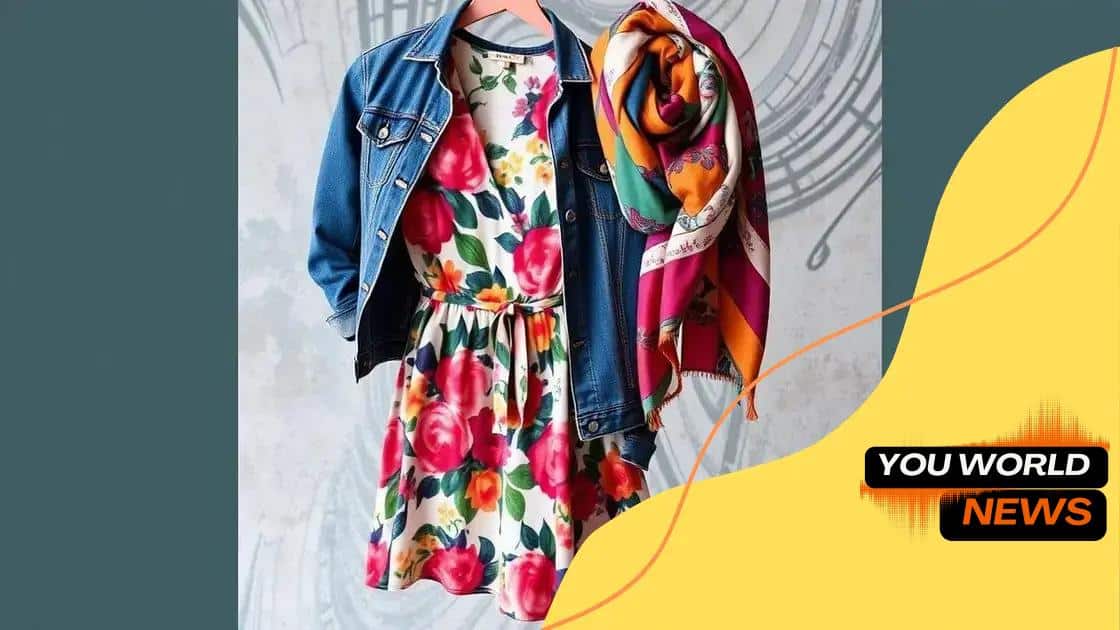Styling tips for mixing textures and fabrics

Mixing textures and fabrics enhances your style by creating depth and visual interest, but achieving a balanced look requires attention to color coordination, proportions, and avoiding common fashion mistakes.
Styling tips for mixing textures and fabrics are essential for creating visually appealing outfits. Have you ever wondered how to elevate your style by harmonizing various textures? Let’s explore some practical tips!
Understanding the importance of texture
Understanding the importance of texture in fashion can truly transform how you style your outfits. Textures add depth and interest, making even the simplest outfit stand out. When you incorporate various materials, you not only enhance the visual appeal but also create a sensory experience.
Why Texture Matters
When mixing different fabrics, texture plays a crucial role. It can change the perception of an outfit entirely. For example, pairing a smooth cotton shirt with a chunky knit sweater can create a balanced look that feels both cozy and chic. The contrast between textures often highlights each piece, drawing attention to your overall ensemble.
Creating Interest with Texture
Texture is also about layering. A well-structured outfit leverages multiple textures to create layers without overwhelming the viewer. Here are some tips for mixing textures:
- Combine soft with structured pieces.
- Use contrasting textures like leather and lace.
- Mix heavy fabrics with lighter ones to create balance.
Don’t forget to consider color when mixing textures. The right color combinations can enhance the textures even more. For instance, a rich jewel tone in a velvet fabric pairs beautifully with a matte fabric, making both stand out. Always think about how different fabrics interact with light and each other.
As you experiment with textures, you’ll discover new styles you may never have considered. A simple addition, like a textured scarf, can elevate your look instantly. Remember, the key to mastering textures is to keep it balanced and harmonious, ensuring that all elements work together seamlessly.
How to combine different fabrics
Combining different fabrics can be a creative and enjoyable process in fashion. It allows you to express your personal style while enhancing the overall look of your outfit. With an understanding of how to merge various textures, you can easily create unique ensembles that stand out.
Choosing Compatible Fabrics
When it comes to mixing fabrics, compatibility is key. Start by selecting fabrics that complement each other. For example, pairing a silky satin blouse with a heavier wool skirt can create an intriguing contrast. Think about how they feel against your skin, too. A balance between smooth and rough textures can add depth to your outfit.
Color Coordination
Color plays a vital role in fabric combinations. Ensure that the colors harmonize well. Here are tips to consider:
- Stick to a color palette to guide your choices.
- Mix solid colors with patterns for added interest.
- Use neutral fabrics to balance out brighter tones.
Experimenting with colors and patterns opens up a world of possibilities. You can create a playful look by mixing a vibrant floral print with a solid-colored piece. Let your creativity shine through!
Moreover, layering different fabrics can enhance your style. Use a lightweight cotton tank under a cozy knit sweater for added warmth and comfort. This layering technique not only keeps you stylish but also allows for seasonal versatility.
As you explore fabric combinations, don’t shy away from bold choices. Combining unexpected materials, such as denim with lace, can turned heads and showcase your fashion-forward thinking. Try out various looks and see what feels right for you.
Color coordination tips for textures

Color coordination is vital when mixing textures to ensure a stylish and harmonious look. By focusing on color, you can enhance the appeal of your outfit and create a striking contrast.
Understanding Color Theory
To effectively combine colors while mixing fabrics, it helps to understand basic color theory. Colors can be classified into categories: warm, cool, and neutral. Combining warm colors like reds and oranges with cool colors like blues and greens can create a vibrant look. On the other hand, sticking to similar hues can yield a beautiful monochromatic scheme.
Layering Colors and Textures
When playing with different textures, consider layering colors to add depth. Start with a base layer in a neutral tone, like beige or gray, then build with layers of more vibrant colors. Here are some tips:
- Use a vibrant top with a textured bottom piece.
- Mix patterns with solid colors to create balance.
- Incorporate contrasting materials to enhance visual interest.
For instance, pairing a denim jacket over a bright floral dress can enhance the overall look. The rugged texture of denim complements the softness of the dress while the colors of the dress pop against the denim’s blue.
Don’t shy away from using accessories to tie your look together. A colorful scarf can add both texture and color, acting as a bridge between different fabrics. When selecting accessories, consider colors that either match or contrast your main outfit to maintain balance.
As you develop your style, experimenting with color combinations can help you discover what works best for you. A well-coordinated color palette not only brings your outfit together but also highlights the distinct textures that make your style unique.
Creating a balanced look
Creating a balanced look is essential when mixing different textures and fabrics. A well-balanced outfit draws attention without overwhelming the viewer. When selecting pieces, think about how they work together in terms of shape, color, and texture.
Mixing Proportions
One way to achieve balance is by playing with proportions. For example, if you wear a loose-fitting top, pair it with fitted bottoms like skinny jeans. This contrast creates a harmonious silhouette. When you mix styles, such as a structured blazer with soft, flowing fabrics, you can maintain a sophisticated and interesting look.
Textures and Visual Weight
Different textures have varying visual weights. Incorporating both light and heavy textures can create a dynamic outfit. For instance, combining a chunky knit sweater with a light, airy skirt adds depth and interest. Keep in mind:
- Use heavier fabrics for statement pieces.
- Balance with lighter materials to avoid bulkiness.
- Consider using neutral colors to unify different textures.
Additionally, consider how the colors of your pieces interact. A balanced color palette can enhance the overall look. Stick to a few colors that complement each other and use them in various textures to tie everything together. Mixing bold colors with neutral tones can also create visual interest without being too flashy.
Accessorizing plays an important role in achieving balance. Adding a belt can cinch a loose dress, creating definition at the waist. Similarly, earrings, bags, or shoes can introduce another layer without overwhelming your outfit. Always remember to choose accessories that align with your outfit’s overall texture and color scheme.
Common pitfalls when mixing fabrics
When mixing fabrics and textures, it’s easy to fall into certain traps that can impact your overall style. Being aware of these common pitfalls can help you create a polished and cohesive look.
Overloading on Patterns
One mistake many people make is overloading their outfit with too many patterns. While mixing patterns can look great, it’s important to maintain balance. Instead of pairing multiple bold prints, choose one standout pattern and combine it with solid colors or more neutral textures.
Ignoring Proportions
Another pitfall is neglecting proportions. Mixing loose and fitted pieces is essential for achieving a balanced silhouette. For example, if you wear a baggy sweater, consider pairing it with tailored pants or a structured skirt. This creates visual interest and prevents your outfit from appearing shapeless.
Color Clashes
Using clashing colors is a common issue that can ruin a well-thought-out look. Always check how colors interact with one another before wearing them together. If uncertain, opt for a monochromatic scheme with various shades of the same color or stick to complementary colors.
Forgetting About Texture
Another mistake is ignoring the textures of each fabric. Each material has its unique feel and visual weight. Mixing heavy materials like denim with lighter fabrics like chiffon requires careful consideration. Using too many heavy or bulky items can make your outfit look overloaded.
- Try to balance heavy fabrics with lighter ones.
- Use texture to create depth in your outfit.
- Avoid fabrics that compete for attention.
Lastly, it’s essential not to forget about comfort. If an outfit feels uncomfortable, it will show in your posture and confidence. Always ensure that your fabric choices are not only stylish but also comfortable to wear. Being mindful of these common pitfalls can help you confidently mix fabrics and create stunning outfits.
FAQ – Frequently Asked Questions about Mixing Textures and Fabrics
What are the key benefits of mixing textures and fabrics?
Mixing textures and fabrics adds depth and interest to your outfits, allowing for more creative expression and a unique personal style.
How do I avoid color clashes when mixing fabrics?
To avoid color clashes, stick to a cohesive color palette and consider using neutral tones to balance brighter colors in your outfit.
What are some common mistakes to avoid when mixing textures?
Common mistakes include overloading on patterns, ignoring proportions, and not considering how different textures work together in terms of visual weight.
How can I create a balanced look with mixed fabrics?
To create a balanced look, mix loose and fitted pieces, use layers to add depth, and ensure that your accessories complement the overall outfit.





